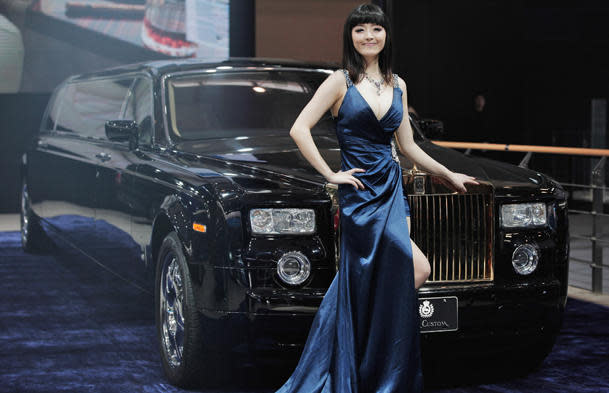 Motoramic
MotoramicCoughing through the sour smell of success at the Beijing Motor Show
You cannot drive to the Beijing Motor Show's press preview. Well, you can, but when you arrive, there does not seem to be a parking lot anywhere in the vicinity of the hall where the event is held. And even if there were, you would need some Shawshank-style skills to transgress the senseless security perimeter that surrounds the venue; a busload of fellow reporters with a full light-and-siren police escort were turned away, repeatedly.
The mystery of this vehement effort at exclusivity only deepens when you enter the China International Exhibition Center—nine separate, cavernous chambers seemingly arrayed around a grid of narrow plazas, but in reality, a convolution of positive and negative space that would confound an Escherite Theseus. The only thing more constricted than the foot traffic here is the air circulation, with dysfunctional air conditioning causing temperatures to hover in the high 80s, off-gassing plumbing that makes the dross trench in a Mumbai slum seem like a Waterworks showroom, and distorted music percussing through the miasma in a manner seemingly designed to procure confessions.
"We're all worried about the Chinese taking over the world right now," a public relations flack said while fanning himself. "Can you imagine what they'll be able to accomplish when they get organized?"
Probably not manufacture a car that could compete outside a captive domestic market, if the vehicles displayed here by the local firms were any indication. If the Korean auto manufacturers are the new Japanese, the Chinese are the new old Koreans—or Yugoslavs. Chinese cars showcase an almost intemperate variety of disinspiration: slathered in a tinsel factory of plastic chrome, mimicking the most contemptible designs of the past two decades (Aztek, last-gen Impala, and Hummer H1 among them), and even seeming to provide the inspiration for Bentley's ignominious EXP 9F SUV concept. Attempting rescue from this Sino-banality was Chery's linked chain of insectoid electric @ant cars that simultaneously conjured hypermiling and "Human Centipede," a baleen Geely GE that made the bilious 2006 Chrysler Imperial concept look restrained, and rumors of a semi-autonomous BYD economy car that could be called up to your doorstep with a remote control — presumably for those Chinese ashamed at their inability to employ a chauffeur.
Opposing this base morass is the local market's insatiable yen (Yuan?) for fanatical opulence, with brands like Bentley experiencing near triple-digit growth this past year. So while it may seem a non-sequitur for the storied British marque to introduce in here a special-edition Mulsanne celebrating the British Queen's Diamond Jubilee, the premiums this superlative model brings at Bentley of Beijing more than justifies the variance. Likewise for the global introduction of the champagne-chilling, dual-iPad integrated, power-activated aluminum tray table swiveling, semi-aniline spuming Jaguar XJ Ultimate Edition, the sensually and redolently upscaled Rolls Royce Ghost Six Senses Edition, the twice-as-nice/twice-the-price Range Rover Evoque Special Edition with Victoria Beckham, and yet another obligatory Bugatti Veyron variant. Also, the metempsychotic reemergence of Maybach.
If ultimate luxury isn't accessible to you, Beijing also proffered lavishness at lower price points, mainly via length. Seemingly motivated by the unmitigated displeasure of navigating the city's choked and chaotic ring roads, an immense range of otherwise masspirational vehicles are contorted at the local factory into chauffeur-ready, extended-wheelbase models: the BMW 3- and 5-Series, the Audi 4 and 6, the Mercedes E. Even Hyundai's top-of-the-bottom Equus is offered here as a chunky Limousine, with a blank panel grafted in aft of the B-pillar. But the award for audacious span must go to the new Citroen DS 9 concept, the Ming-era Great Wall of horizontality, featuring an axle-to-axle measure roughly twice that of a 13-passenger van.
Speaking of vans, we quite fancied GMC's local custom coaches, which looked from the outside like they should have been parked in the lot of the Pontiac Silverdome, billowing pungent smoke before an Eagles concert in 1979, but were kitted out inside like Piaggios, rendering them capable of ferrying a passel of Chinese executives in a style formerly reserved for the market-beloved Buick GL-8 minivan. Too bad Honda and MG couldn't recall their own Malaise Era glory with their Beijing introductions. Where late-70s Accords were almost Italian in their styling, the brand's new sedan looked like it had gout, a condition that was not aided by the fact that it appeared to feature on its fascia every single strake, vent, slant, stroke, and squint that sister brand Acura had recently banished from its model line. Worse, was the Morris Garage's jacked-up, soft-road, Icon concept which, while featuring the sloping backlight and finny tail of the classic MG-B GT, looked hyperopic and Bactrian, like a Morgan Aeromax with an Acura ZDX stuck in its throat.
Which kind of feels like a metaphor for the entire Beijing show: a mimetic mélange of memorable cues, assembled recklessly — and often cynically — and leaving you longing for an expectorant.
Brett Berk's automotive writing has appeared in Businessweek, Car and Driver, Esquire, GQ.com, Jalopnik, The L.A. Times, and in Vanity Fair where he writes a weekly online car column, and covers the category for the magazine. Visit him at brettberk.com or follow him @StickShift_VF.

 Yahoo Autos
Yahoo Autos 



